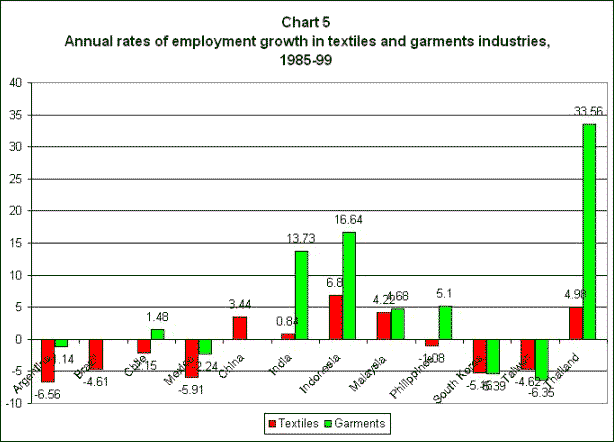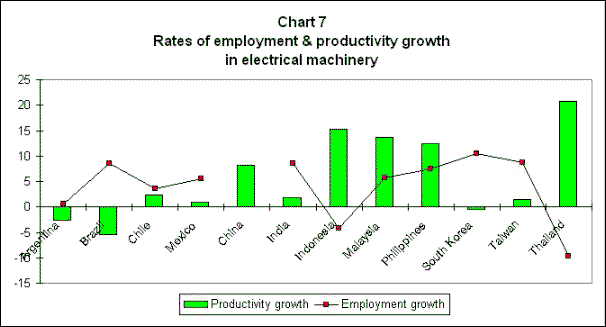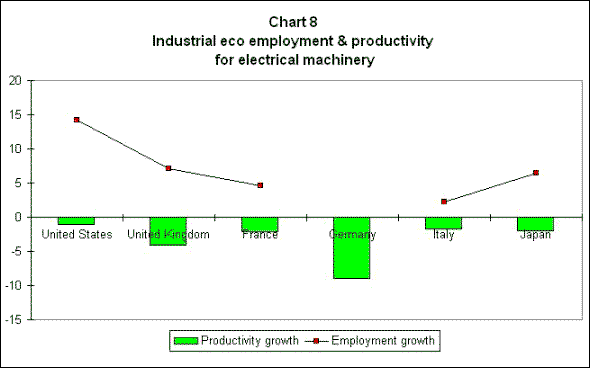In
addition, the state sector in China continued to account
for a very substantial share of manufacturing employment,
and this was largely protected over the decade. This
meant that any increase in export-oriented employment
would translate into net additions to jobs, unlike
other countries in the region where they would merely
counter the effect of job losses in industries catering
to the domestic market. It is unlikely that this momentum
can be sustained after the entry of China into the
WTO, and the rate of net job creation is therefore
likely to decelerate.
The other country exhibiting very high rates of growth
of manufacturing employment over this period was Malaysia.
Once again, the role of the state has been substantial
in ensuring and protecting employment through various
means in this economy, even though most of the manufacturing
employment is in the private sector.
One of the main areas in which developing countries
are widely perceived to have comparative advantage
in trade is in textiles and clothing. This is why
the Uruguay Round Agreement on Textiles and Clothing
was seen as a major concession to developing countries,
and encouraged them to accept other less palatable
aspects of the overall GATT agreements signed at the
time. Of course, this particular agreement was back-loaded
in terms of relegating most of the required liberalisation
to the end of the period.
Meanwhile, in this period during which the Multi-Fibre
Agreement was to be phased out, developed countries
were allowed a series of "transitional measures"
which effectively meant increased protectionism in
this sector. Problems of worsened conditions
of market access have dominated developing country
complaints in this regard. Nevertheless, as can be
noted from Chart 1, aggregate textile exports over
the decade of the 1990s increase at an annual rate
of 4 per cent, and that of clothing at 6 per cent,
and it is likely that most of these increases went
to developing country exporters.
But consider what has happened, in this context, to
employment in this sector in the major developing
country exporters, as displayed in Chart 5. Many developing
countries – especially those in Latin America and
among the more developed in the East Asian region
– have actually experienced absolute declines in employment
in textiles and clothing. Where the rate of increase
in employment in the garments sector has been very
high – as for example in Thailand and Indonesia –
it has been from a very low base. Overall, the data
do not give the impression any significant shift in
terms of shift in employment in the textiles and clothing
sector.

Chart
5 >> Click
to Enlarge
Leather goods and footwear is the other area of traditional
manufactured exports of developing countries, and
even in this sector, as is clear from Chart 6, employment
generation has been less than impressive for the major
developing country exporters. Once again, the two
countries showing very high rates of employment expansion
– Indonesia and Thailand – had very low bases in 1985.

Chart
6 >> Click
to Enlarge
Of course, the real point about relocative manufacturing
production is that it is not supposed to be confined
to areas of traditional exports of developing countries,
but to extend into those areas which were typically
seen as the preserve of developed industrial nations.
In fact, much of the export success of the more dynamic
developing countries of this period was related to
their association with the "sunrise" industries,
such as the electronics and computer/IT hardware related
sectors.
These can be broadly captured in the UNIDO dataset
in the categories "electrical machinery"
and "scientific and professional equipment".
Charts 7 and 8 show the pattern of employment and
productivity in the electrical machinery sector for
some major developing and developed country exporters,
respectively. This yields some surprising results.
To begin with, while rates of employment growth in
this sector vary across countries, it is true that
some Asian countries show very high rates, as expected
given their focus on these exports and their increasing
shares of the world market in this sector.

Chart
7 >> Click
to Enlarge

Chart
8 >> Click
to Enlarge

